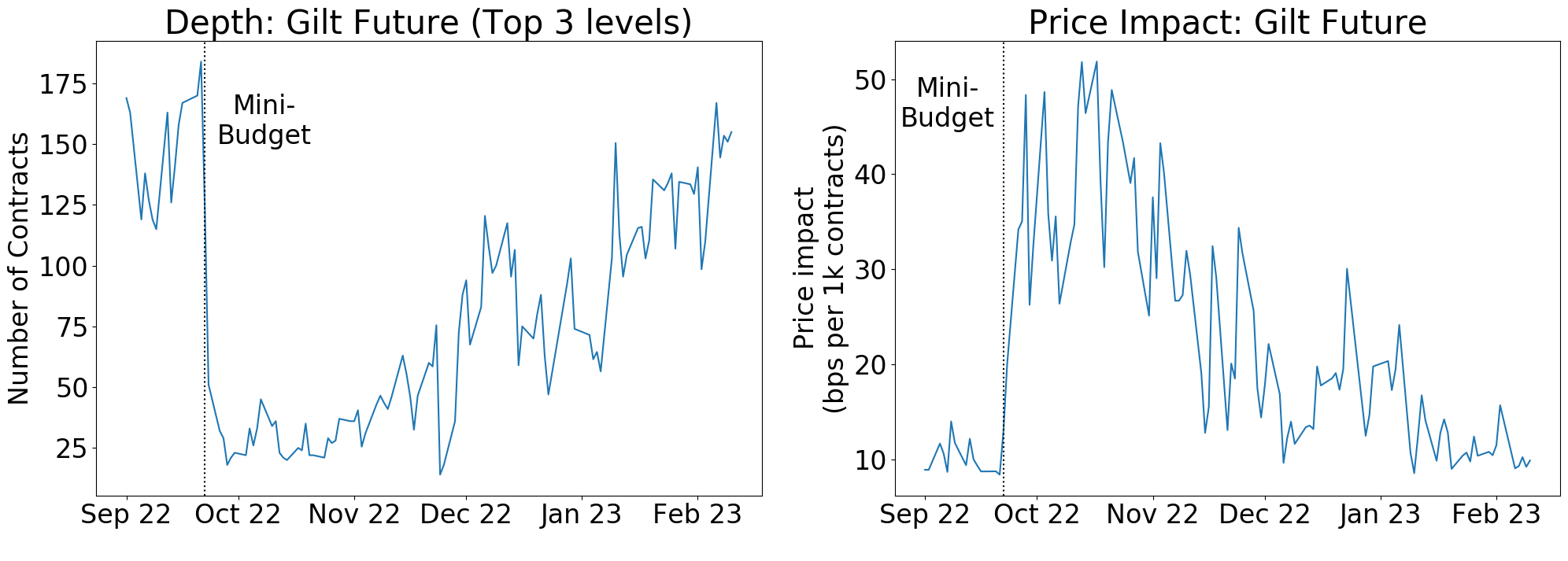Joel Mundy and Matt Roberts-Sklar
When markets are volatile, liquidity tends to worsen. This makes it harder to intermediate buyers and sellers. We saw this during the 2022 liability-driven investment (LDI) stress, when the UK government bond (gilt) market exhibited extreme volatility. This illiquidity was also evident in gilt futures, derivatives that support functioning in the cash gilt market. Gilt futures are traded on an electronic orderbook, meaning we can examine liquidity metrics at very high frequency. Looking across a range of liquidity metrics for gilt futures, we find that liquidity was broadly unchanged following the Monetary Policy Committee’s (MPC’s) decision of 22 September 2022. But market functioning deteriorated heavily following the UK Government’s fiscal statement of 23 September and took a long time to recover.
Market illiquidity during the 2022 LDI stress
Since the 2008 financial crisis, UK financial markets have endured a series of volatile episodes, each testing liquidity and market functioning. These market disturbances can quickly lead to an unwarranted tightening of financing conditions and a reduction of the flow of credit to the real economy. Therefore, we are interested in how core UK markets cope with stress and how quickly they recover once disruptions recede.
The 2022 LDI stress has been discussed extensively elsewhere. Following the UK Government’s fiscal statement of 23 September, the gilt market exhibited extreme volatility. The gilt market became imbalanced, characterised by one-way selling pressures. As a result, gilt market intermediation started to break down and market functioning deteriorated rapidly. Gilt yields were very volatile during this period (Chart 1), especially at longer maturities.
Chart 1: Yield implied by gilt future (~10yrs maturity)
Sources: BMLL Technologies and Bank calculations.
Gilt futures
In this post, we focus on liquidity in the gilt futures market during the LDI stress. Gilt futures are financial derivatives that are typically used to gain exposure to cash gilts, ie the actual bonds. Buyers of gilt futures commit to buy a cash gilt at a set price in a predetermined date, while conversely, sellers commit to sell a cash gilt under the agreed terms. Gilt futures are vital instruments for hedging in the gilt and associated interest rate derivatives market. Gilt futures aid price discovery and facilitate hedging in the cash gilt market, thereby supporting the transmission of monetary policy and financial stability. The close link between these markets means gilt futures provide a useful window into liquidity during the stress.
To trade gilt futures, market participants can submit ‘market orders’ (which are executed immediately) or ‘limit orders’ to the electronic ‘orderbook‘, detailing the price and quantity of contracts they would like to trade. Limit orders stay on the orderbook until they are either executed (when someone takes the other side of the order) or cancelled by the participant.
All changes to the orderbook are recorded. We use these high-frequency data to analyse liquidity of gilt futures during the LDI stress.
A baseline for liquidity
During the LDI stress, the gilt futures market experienced similar challenges to the cash gilt market. To identify the impact of the stress, we use 1 September 2022 as our baseline. This was a relatively quiet day before the stress built. We largely focus our analysis on the then active long gilt future: the December 2022 contract, which referenced gilts maturing between 2032 and 2035.
As discussed in this Bank Underground post, there are many ways to assess market conditions. Here, we use four metrics, which we plot in Chart 2 for our baseline day at five-minute intervals. The left-most plot shows the yield implied by the price of the gilt future. Next is the number of orderbook events, the number of times orders are added, modified, cancelled or executed. The third plot is market depth, which is the number of contracts that are ready to be traded at the three most competitive buy and sell prices. More depth means better liquidity as, all else equal, more can be traded without affecting the price. The final plot shows the price impact, which estimates how prices respond to a given change in the orderbook.
Chart 2: Gilt futures – 1 September 2022
Sources: BMLL Technologies and Bank calculations.
On our baseline day, the yield changed little. Orderbook events were fairly evenly spread over the day, dipping around lunchtime and after the 4.15pm cash gilt market close. Similarly, depth and price impact were fairly constant at typical levels over the day.
We use this combination of plots, with the same y-axes, to analyse the gilt futures market during five key days of the LDI stress.
Key day 1 – 22 September 2022 – MPC Decision
In the lead up to the MPC’s September meeting, global yields had increased noticeably, but liquidity had held up well. The MPC was scheduled to announce the outcome of the meeting at midday on the 22 September 2022. In the morning before the MPC’s announcement, the yield was flat and then drifted higher after the midday announcement (Chart 3). As is typical ahead of scheduled events, market makers temporarily stepped back from the market and depth fell. After the event, market makers returned and replenished the orderbook. This explains the unsurprising increase in the number of orderbook events around the announcement. Price impact was at typical levels over the course of the day, suggesting liquidity was broadly unchanged. So while yields did increase after MPC’s announcement, this was an orderly repricing with no persistent impact on liquidity metrics.
Chart 3: Gilt futures – 22 September 2022
Sources: BMLL Technologies and Bank calculations.
Note: Horizontal dashed lines represent average values on baseline day (1 September 2022).
Key day 2 – 23 September 2022 – ‘mini-budget’ day
On 23 September 2022, at shortly after 9.30am the Chancellor of the Exchequer delivered the mini-budget statement to the House of Commons. By the time the statement concluded half an hour later, 10-year yields increased by around 25 basis points, a large move in such a short time period (Chart 4). Moves in longer maturity yields were larger.
Chart 4 reveals activity on the gilt futures orderbook during this 30-minute period. Green dots show the yield of all orders added to the orderbook, orange dots represent executed orders and the black line shows the last yield. Even though the yield moved sharply, the move was continuous, with orders consistently added to the orderbook. There were no ‘air gaps’ (periods of time with no executed orders).
Chart 4: Gilt futures during the mini-budget day
Sources: BMLL Technologies and Bank calculations.
However, the absence of air gaps does not mean the market was functioning well.
Turning to our four measures, the jump in yields can be seen on the left. As yields rose during the mini-budget statement, the number of orderbook events increased, as given the volatility, orders were frequently adjusted. Chart 5 shows orderbook depth fell sharply shortly after the statement began and price impact rose. This shows that although the yield changes happened without sudden air gaps, market conditions were still extremely challenging, with market makers reducing risk on the orderbook (as shown by lower depth and higher price impact) given heightened volatility. This meant users of gilt futures found it more difficult to trade, reducing their ability to, for example, manage risk.
Chart 5: Gilt futures – 23 September 2022
Sources: BMLL Technologies and Bank calculations.
Note: Horizontal dashed lines represent average values on baseline day (1 September 2022).
Key days 3 and 4 – 26 and 27 September 2022 – the stress builds
By the Monday, stress was continuing to build (Chart 6). There was a flurry of orderbook events when trading opened but then activity dwindled (aside from around 4.15pm cash gilt close pricing). Depth remained low and price impact remained high. Yields crept up over the late afternoon.
Chart 6: Gilt futures – 26 September 2022
Sources: BMLL Technologies and Bank calculations.
Note: Horizontal dashed lines represent average values on baseline day (1 September 2022).
The stress built further on the Tuesday (Chart 7), with yields rising over the afternoon, depth falling even further to almost zero, and price impact rising further.
Chart 7: Gilt futures – 27 September 2022
Sources: BMLL Technologies and Bank calculations.
Note: Horizontal dashed lines represent average values on baseline day (1 September 2022).
Key day 5 – 28 September 2022 – Bank of England announces gilt purchases
On the morning of Wednesday 28 September, conditions remained poor. At 11am, the Bank of England announced temporary and targeted gilt purchases.
Chart 8 shows how the market responded to the announcement, analogous to Chart 4. In the minutes after the announcement, the yield fell by over 30 basis points. As was the case during the mini-budget statement, the repricing was continuous without air gaps: orders continued to be added to the book and the yield moved continuously.
Chart 8: Gilt futures around the time of the Bank of England gilt purchase announcement
Sources: BMLL Technologies and Bank calculations.
Chart 9 puts this move in the context of the day’s activity. It shows that when the yield fell sharply, there was a huge spike in orderbook events. Throughout the day, depth remained extremely low. However, there was a fall in price impact during the day, reflecting some improvement in liquidity.
Chart 9: Gilt futures – 28 September 2022
Sources: BMLL Technologies and Bank calculations.
Note: Horizontal dashed lines represent average values on baseline day (1 September 2022).
What happened next?
Chart 10 zooms out and shows depth and price impact at a daily frequency. The deterioration in both metrics during the LDI stress is clearly visible. Both measures suggest liquidity in gilt futures did improve after the Bank of England’s intervention, but only gradually. Depth and price impact did not revert to their pre-LDI levels until February 2023, nearly five months after the stress.
Chart 10: Daily time series of orderbook depth and price impact
Sources: BMLL Technologies and Bank calculations.
Conclusion
Market functioning deteriorated during the LDI stress. This is typical: when volatility is high, market intermediaries often step back, reducing market depth and increasing price impact. More broadly, this case study demonstrates market conditions can deteriorate quickly in a stress, but recover slowly. In this case, monitoring the sorts of liquidity metrics in futures markets shown above – along with similar measures for the cash gilt market, and always combined with market intelligence – helped policymakers understand this stress. Going forward, it is important to continue to monitor these kind of metrics to understand market conditions on an ongoing basis.
Joel Mundy and Matt Roberts-Sklar work in the Bank’s Market Intelligence and Analysis Division.
If you want to get in touch, please email us at [email protected] or leave a comment below.
Comments will only appear once approved by a moderator, and are only published where a full name is supplied. Bank Underground is a blog for Bank of England staff to share views that challenge – or support – prevailing policy orthodoxies. The views expressed here are those of the authors, and are not necessarily those of the Bank of England, or its policy committees.
Share the post “Futures under stress: how did gilt futures behave in the LDI crisis?”
Publisher: Source link











